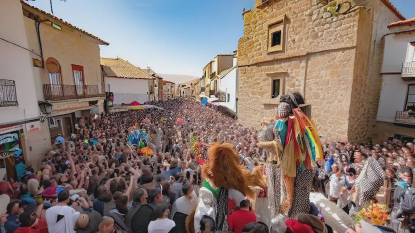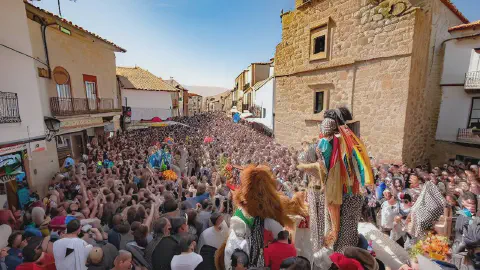
Camino Francés: Hornillos Del Camino to Castrojeriz - Stage 14
Posted: | Updated:
Reading time: 10 minutes
Camino Francés: Hornillos Del Camino to Castrojeriz - Stage 14
Posted: | Updated:
Reading time: 10 minutes
By: Simon Kemp, Editor
The Camino Francés continues from Hornillos del Camino, a small village with medieval roots, to Castrojeriz, a town shaped by centuries of trade and pilgrimage. This section of the route crosses the Meseta, a vast plateau known for its open landscapes and long, uninterrupted stretches of trail.
Historical Background
- Hornillos del Camino: This village has been a stopping point for pilgrims since the Middle Ages. It was once an important settlement along the Camino, offering shelter and supplies to travelers. Though small today, its history is reflected in the Church of San Román, a modest but significant structure dating back to the 16th century.
- Castrojeriz: A larger town with a long history tied to the Camino, Castrojeriz was a strategic location during medieval times. It was home to monasteries, hospitals, and fortifications, serving both pilgrims and merchants. The ruins of San Antón Convent, just before reaching the town, are a reminder of the Antonine monks who cared for travelers suffering from Saint Anthony’s Fire, a disease caused by ergot poisoning.
The Camino Route
The journey from Hornillos del Camino to Castrojeriz spans approximately 20 km and follows a well-worn dirt path through the Meseta. The route is straightforward but exposed, with little shade and few villages along the way.
- Hornillos del Camino to Hontanas (10 km): The trail begins with a gentle incline before leveling out into open fields. The village of Hontanas appears suddenly in a small valley, offering a welcome break with cafés and accommodations.
- Hontanas to San Antón Convent (5 km): Leaving Hontanas, the path continues through farmland before reaching the ruins of San Antón Convent, where the remains of the monastery arch over the Camino itself.
- San Antón Convent to Castrojeriz (5 km): The final stretch leads into Castrojeriz, a town built along a single main street that follows the Camino. The ruined castle on the hill above the town is a reminder of its medieval past.
This section of the Camino is relatively easy in terms of elevation, but the lack of shade and long distances between villages make it important to carry enough water and supplies. Pilgrims often describe this part of the journey as meditative, with the wide-open landscape offering a sense of solitude and reflection
Stage 14 of the Camino Francés from Hornillos Del Camino to Castrojeriz spans approximately 20 kilometers. The route takes you through the scenic beauty of the wide-open Meseta, with its flat expanses and wheat fields. (Image: The Festival de la Cruz in Castrojeriz, northern Spain)
The stage involves passing through Hontanas and the 14th-century ruins of the San Antón Convent before reaching Castrojeriz. The terrain includes well-worn dirt paths, some paved sections, and a gradual ascent towards Castrojeriz. The highlights of this stage include natural springs in Hontanas, the atmospheric San Antón Convent ruins, and the medieval charm of Castrojeriz.
The potential challenges include dealing with the elements, especially the harsh sun on the open Meseta, and the stamina required for the climb to Castrojeriz. Rest stops are available in Hontanas and Castrojeriz, providing facilities for pilgrims. Hornillos Del Camino offers a tranquil ambiance, architectural treasures, a haven for pilgrims, natural splendor, and local culinary delights. Similarly, Castrojeriz boasts architectural splendor, natural beauty, pilgrim facilities, local traditions, and culinary delights.
Hornillos Del Camino to Castrojeriz Route Map
Hornillos Del Camino to Castrojeriz Route Description
This stage of the Camino Francés spans approximately 20 kilometers (around 12.4 miles).
A. Detailed Breakdown of the Route
- Hornillos Del Camino to Hontanas (10 km) Depart from Hornillos Del Camino, a charming, compact village set in a shallow valley. As you leave, enjoy the scenic beauty of the wide-open Meseta, with its flat expanses and wheat fields stretching as far as the eye can see. Your destination is Hontanas, a ‘hidden’ village that gets its name from the many natural springs (fontanas) in the area. The Iglesia de la Inmaculada Concepción is a noteworthy landmark in this rustic hamlet.
- Hontanas to San Antón Convent Ruins (5 km) Upon leaving Hontanas, you’ll walk through the settlement of San Bol. Although small, it offers an optional detour to an isolated albergue and a natural spring, perfect for a refreshing pause. The route then takes you to the 14th-century ruins of the San Antón Convent, an atmospheric site that arches over the camino itself. Historically, the Antonine monks living here provided care for pilgrims afflicted with Saint Anthony’s Fire.
- San Antón Convent Ruins to Castrojeriz (5 km) The final stretch takes you along an open plain leading to the inviting village of Castrojeriz. Nestled at the foot of a hill and crowned by a ruined castle, Castrojeriz offers a delightful mix of medieval architecture and warm hospitality. Its long history with the Camino is evident in the welcoming atmosphere and the many services available for pilgrims.
B. Terrain and Elevation
The terrain involves well-worn dirt paths, some sections of paved road, and a gradual ascent as you near Castrojeriz. The scenery throughout this stage includes the open landscapes of the Meseta, offering panoramic views and a sense of tranquility.
C. Points of Interest
- Natural springs in Hontanas: Visit the springs that gave Hontanas its name. These natural features are a refreshing sight for pilgrims journeying through the Meseta’s arid landscape.
- San Antón Convent Ruins: These atmospheric ruins represent a fascinating slice of Camino history. Walking under the arch that once served as the convent’s entrance is a unique experience many pilgrims treasure.
- Castrojeriz: Explore the village’s medieval charm, from its ruined castle to the multiple churches like the Iglesia de Santo Domingo and Iglesia de San Juan. The village’s long Camino history and architecture make it an inviting end to your day.
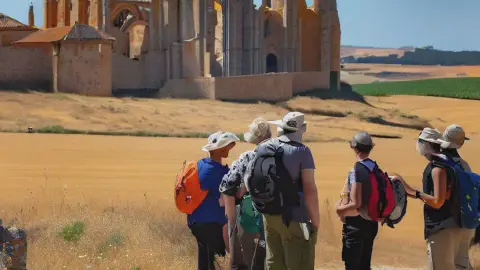
D. Potential Challenges
The most significant challenge on this stage is dealing with the elements. The open Meseta can be harsh under the summer sun, making sun protection essential. Additionally, the climb to Castrojeriz might test your stamina but remember, the breathtaking views from the top make the effort worthwhile.
E. Rest Stops
Hontanas serves as a perfect halfway rest stop with a few facilities for pilgrims. Once in Castrojeriz, you’ll find a variety of services including albergues, bars, restaurants, and a small supermarket where you can replenish and prepare for the next day’s journey.
This stage offers a peaceful walk through the Spanish countryside, allowing you to soak in the tranquil beauty of the Meseta. Buen camino!
Departure Point: Hornillos Del Camino
Welcome to Hornillos del Camino, a serene and picturesque town situated along the Camino de Santiago pilgrimage route in northern Spain.
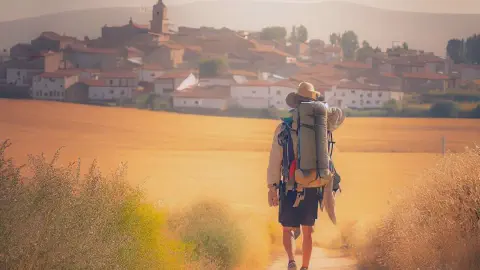
Location and History
Arriving here by walking from Burgos to Hornillos del Camino , you will discover that Hornillos del Camino holds a special place as a resting point for weary pilgrims embarking on the sacred Camino de Santiago. This town has stood as a humble guardian of the pilgrimage tradition, offering respite and essential services to travelers on their spiritual journey.
Tranquil Ambience
Hornillos del Camino exudes a tranquil and harmonious atmosphere that envelops visitors in a peaceful embrace. The gentle rustling of leaves, the soft whispers of the wind, and the soothing songs of birds create a serene symphony that soothes the soul. It is a place where one can find solace, reflect on the inner journey, and reconnect with nature.
Architectural Treasures
Discover the architectural treasures that adorn Hornillos del Camino, speaking volumes about its historical and cultural heritage. The Iglesia de San Román, a graceful Romanesque church dating back to the 13th century, stands as a silent witness to the passage of time. Its sturdy stone walls, elegant arches, and intricate carvings reflect the craftsmanship of yesteryears and invite contemplation and reverence.
Pilgrim Haven
Hornillos del Camino extends a warm welcome to pilgrims, offering a haven of rest and support. Albergues (hostels) provide weary travelers with comfortable accommodations, a place to lay their heads, and share tales of their journey. The community’s hospitality knows no bounds, with locals offering a helping hand, a kind smile, and words of encouragement to pilgrims, forging connections that transcend borders and languages.
Natural Splendor
Natural splendor surrounds Hornillos del Camino. Endless fields stretch as far as the eye can see, painting a breathtaking landscape of vibrant colors and gentle rolling hills. Witness the ever-changing canvas of the sky as it bathes the earth in warm hues during sunrise and sunset. This tranquil setting invites contemplation and renews the spirit of pilgrims as they connect with the beauty of the natural world.
Local Delights
Indulge in the flavors of Hornillos del Camino, where traditional cuisine tantalizes the taste buds. Delight in the succulent flavors of lechazo asado, tender roast lamb infused with aromatic herbs and cooked to perfection. Sample the rich and savory morcilla de Burgos, a traditional blood sausage made with a unique blend of spices. Pair these culinary delights with a glass of local wine, savoring the essence of the land with each sip.
Hornillos del Camino, with its serene ambiance, architectural wonders, warm hospitality, and breathtaking natural surroundings, invites you to embark on a transformative journey. Find solace in its tranquility, connect with fellow pilgrims, and connect with the history and spirituality. Let Hornillos del Camino be your sanctuary along the Camino de Santiago, a place where the soul finds peace, and the spirit is renewed.

Destination: Castrojeriz
Welcome to Castrojeriz, a captivating town situated in the heart of the Spanish countryside, where history, natural beauty, and spirituality converge.
Location and History: Castrojeriz
Situated in the province of Burgos, Castrojeriz enjoys a picturesque location on a hill overlooking the expansive plains of Castilla y León. This town has a rich history that dates back to ancient times. Archaeological findings suggest the existence of settlements in the area since the Roman era, making Castrojeriz an important site along the historical timeline.
Architectural Splendor
Castrojeriz boasts an impressive architectural heritage that reflects its historical importance. The Iglesia de Santa María del Manzano, a stunning Gothic church dating back to the 13th century, stands as a remarkable testament to the town’s religious devotion. Its intricate stone carvings, towering spires, and beautifully crafted altarpieces capture the essence of medieval craftsmanship.
Another notable landmark is the Castillo de Castrojeriz, a medieval fortress that once served as a stronghold for the town. The ruins of the castle still stand today, offering glimpses into its storied past. Ascend to the top of the tower and be rewarded with panoramic views of the surrounding countryside, including the winding paths of the Camino de Santiago.
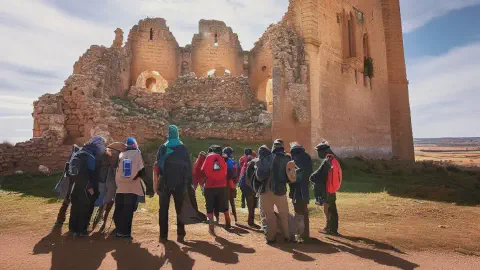
Natural Beauty
Nestled amidst rolling hills and fertile farmland, Castrojeriz captivates visitors with its natural beauty. The expansive fields, adorned with colorful wildflowers, create a picturesque backdrop for leisurely walks and moments of contemplation. Nature enthusiasts can explore the nearby Monte de Mostelares, a scenic hill that offers stunning vistas of the town and its surroundings, providing a perfect spot for photographers and hikers.
Pilgrim Haven: Castrojeriz
As a significant stop along the Camino de Santiago, Castrojeriz has long been a haven for pilgrims on their spiritual journey. Albergues (hostels) provide comfortable accommodations for weary travelers, offering a place to rest, share stories, and forge connections with fellow pilgrims. The town’s warm hospitality extends to its restaurants and cafes, where pilgrims can savor regional delicacies and experience the conviviality of the Camino community.
Local Traditions
Castrojeriz embraces its rich cultural traditions, which are often celebrated during annual festivals and events. The Festival de la Cruz, held in May, is a vibrant celebration that pays homage to the Christian cross. Colorful processions wind through the streets, accompanied by traditional dances and music, creating a lively atmosphere that showcases the town’s deep-rooted customs.
Culinary Delights
Indulge in the flavors of Castrojeriz and experience the region’s gastronomic delights. Delight your taste buds with lechazo asado, a succulent roast lamb dish, slow-cooked to perfection and seasoned with aromatic herbs. Another local specialty is migas, a hearty dish made from breadcrumbs, garlic, and olive oil, often accompanied by flavorful sausages and vegetables. Pair these culinary delights with a glass of renowned Ribera del Duero wine, produced in the vineyards that dot the surrounding countryside.
The next stage of the Camino Francés will take you from Castrojeriz to Fromista .

